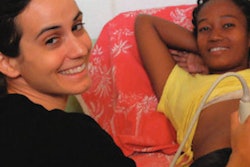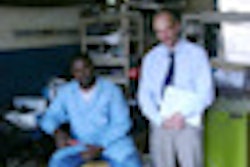It's not how advanced your healthcare technology is, it's how many people benefit from it that counts in an age of stark and growing contrasts between healthcare delivery in rich versus underdeveloped nations.
Aiming to address healthcare needs in the developing world, GE Healthcare of Chalfont St. Giles, U.K., is betting on global education networks, technology from the developing world, and proven imaging technologies that are more durable and cheaper than the state-of-the-art systems that define technology in the world's wealthier nations.
The goal of the company's new push, besides the eventual profits, is to deliver imaging technology to millions who lack access. One focus of the new global strategy is the company's CT for Africa program, which will deliver low-cost single- and dual-slice scanners to hospitals in at least 13 African countries that have mostly gotten by on ultrasound and radiography or, in some cases, no imaging at all.
The move is part of GE's new Global Imagination initiative to provide scanners where none have gone before, using a combination of technology honed in developing countries and equipment that can be sold and maintained at a low cost.
Unmet needs
The social-entrepreneurial approach to business development, which is gaining popularity in a number of business sectors, might be viewed as a primer for any company looking for ways to profit in mature markets where money is scarce but the human needs are vast and unmet.
At the 2010 Computer Assisted Radiology and Surgery (CARS) congress in Geneva, Robert Sigal, MD, PhD, talked about the firm's CT for Africa project in the context of patients without access to care.
"What we're thinking as a company today is that we have to shift our focus to something different," said Sigal, who is GE's general manager for enterprise and market development. "We have to think in terms of technological excellence, but we also have to focus on our costs. We have to think globally in terms of the quality of the product -- but also in terms of access for the patient, access for the professional -- and costs, because cost is becoming the most important issue. If you don't consider this issue from the beginning, then you are excluding billions of people from healthcare."
GE recently launched its CT for Africa initiative in cooperation with the 10-year-old not-for-profit Réseau en Afrique Francophone pour la Télémédecine (RAFT) initiative to promote teleradiology in French-speaking Africa.
The RAFT network provides education sessions to hundreds of professionals in French- speaking African countries, Sigal said. Launched in Mali in 2000, the network has since expanded to 15 African countries, including Mauritania, Morocco, Cameroon, Burkina-Faso, Senegal, Tunisia, Ivory Coast, Madagascar, Niger, Benin, Burundi, and Chad. The project is focused on establishing a multinational telemedicine network designed to link healthcare institutions in Francophone African countries for collaborative teleteaching and teleconsultation.
"The RAFT project is aimed at answering the challenges which exist in rural hospitals in the developing world, [where] very often there is insufficient or no diagnostic imaging equipment at all," Sigal said. Rural healthcare is the most underserved component in these countries, he said, for four principal reasons:
- Limited local funds
- Poor infrastructure
- Few doctors and technologists
- No hospitals, only small clinics
"Even when there is equipment, usually the main problem is the lack of qualified radiologists and technologists," said Sigal. According to 2004 figures, the latest official figures available for the World Health Organization, fewer than 100 radiologists were working in rural regions in the 18 countries RAFT is serving in French-speaking Africa.
For training and education, GE's partnership with RAFT is focused on low-bandwidth distance education that provides interactive webcasting at 200-kbps bandwidth to more than 100 sites simultaneously, Sigal said.
"All of the education is supported by Web-based portals," he said. "Onsite training will also be organized in the county and also by taking some of the radiologists to Geneva for training."
Indeed, an important role is shaping up for Geneva University Hospitals, which will manage knowledge-sharing between the various participants in all of the hubs, spokes, and support hospitals in the CT for Africa program, Sigal said.
CT for Africa within the network
GE's CT scanner of choice, some 36 of which are envisioned for the initial 12 countries in the program, is the Brivo 325 model, which comes in one- and two-slice configurations and carries a list price of about $200,000, versus $400,000 to $500,000 for more technologically advanced models, Sigal said.
The scanner comes with a built-in teleradiology component, GE financing, and a three-year warranty, as opposed to the one-year warranty period for most scanners sold in the West, Sigal said. Without the long-term warranty and the assurance that the equipment will be maintained properly, scanners sold in developing countries are prone to falling into disrepair, he said.
Funding by individual governments will pay for the majority of capital expenditures, he said, and funds will also be generated on an ongoing basis to fund the programs.
Income for operations will also be part of the mix. Each CT exam will be paid according to the current fee rate in each country, currently about $30, Sigal said. Patients seeking a second opinion will be able to obtain one for an additional $5 per exam, with a limited number provided free of charge, Sigal said. The training and charitable education costs will be covered 100% by charitable organizations.
Slow start in Niger
The program is off to a good start, despite some delays, Sigal said. "In Nigeria, unfortunately, there has been some political unrest, so the pilot [project] which was ready to be deployed recently experienced some delays for purely political reasons." As of this week the project remains on hold, an assistant to Sigal told AuntMinnie.com.
The Web-based educational initiative is now active in 18 countries with a network of 30 local coordinators and five collaborators at Geneva University Hospitals, Sigal said.
A total of 16 hours of courses are now provided each month, 80% of which are produced in Africa, Sigal said. On average, 18 different sites are now connected for these courses. The record for a single course was 42 sites with "e-discussions" involving 1,000 participants. For now, the network is deployed mostly in the better equipped "reference hospitals" comprising some 30 active sites in national regional hospitals in the 18 countries, as well as a few in remote sites (15 district and rural hospitals).
The key to expanding access lies in a holistic approach to rural healthcare that takes sustained aim at capacity development, health systems integration, and business model innovation in the target regions.
In the functioning network that is being cobbled together in each location, CT images acquired in a district hospital are sent to a workstation and eventually uploaded via satellite, where they can be downloaded via land lines to the university hospitals in the country as well as to support hospitals in the developed world, including the Geneva University team, Sigal said.
The broader view
The blueprint for development and sharing of cheaper, more effective technology is not exclusive to Africa, and it's being applied in other regions where access to healthcare is scarce, Sigal said. For example, ultrasound technology developed in India is used to equip mobile health vans that travel to rural areas.
An offshoot of the Indian program is being expanded to Bangladesh, where low-cost ultrasound developed in India is being deployed in partnership with local physicians "to diagnose pregnancy and problems with pregnancy in rural Bangladesh," Sigal said.
"In general, what we're looking at is the evolution of healthcare innovation," he said. Traditionally, innovation has been focused on solutions developed mostly in the U.S. "and then rolled out for the rest of the world," he said.
Today, costs are a central concern, and failing to keep them in check literally means denying access to healthcare for people in developing nations, Sigal said.
"The innovations can be developed anywhere and shared globally," he said, and just as important as cost is the type of technology that is developed in the global partnerships, he said.
In the case of ob/gyn ultrasound being exported to Bangladesh, it was Indian technology that happened to fit the market "not because it's cheaper to manufacture there, but because the [less sophisticated] instruments would never have been developed in a country like Germany," Sigal said.
Considering the world's massive healthcare needs -- a world in which millions go without care and many countries face aging populations that need more and cheaper healthcare services -- the global cooperation and development model is an important way to start addressing the shortfall, he said.
By Eric Barnes
AuntMinnie.com staff writer
November 4, 2010
Related Reading
Radiology IT explores new frontiers, February 18, 2010
Haiti after the earthquake: Idaho RT assists relief effort, January 28, 2010
Radiology mobilizes to help Haiti in wake of devastating earthquake, January 19, 2010
UN's IAEA launches pediatric rad therapy network, September 14 2009
Radiotherapy access must be improved in developing world: UN, June 27, 2003
Copyright © 2010 AuntMinnie.com


















